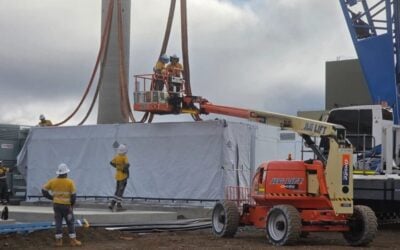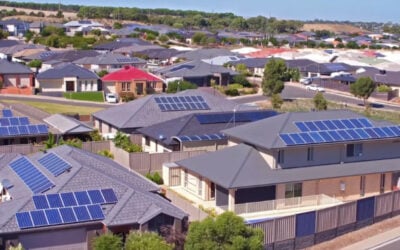Tesla’s lithium-ion ‘Gigafactory’ will be built in Nevada, after company officials including chief executive officer Elon Musk appeared alongside the US state’s governor at a press conference held yesterday afternoon.
Nevada state governor Brian Sandoval held a news conference at 4pm local time, in Carson City. News outlets including local paper Reno Gazette-Journal and the New York Times reported that the state offered Tesla tax incentives worth as much as US$1.25 billion, far exceeding the US$500 million in incentives the company had requested from the chosen state. Industry estimates have put the cost of building the factory at about US$5 billion.
Enjoy 12 months of exclusive analysis
- Regular insight and analysis of the industry’s biggest developments
- In-depth interviews with the industry’s leading figures
- Annual digital subscription to the PV Tech Power journal
- Discounts on Solar Media’s portfolio of events, in-person and virtual
The site of the factory has been the subject of much speculation and discussion, with five states competing for the right to host the facility. Nevada was in direct competition with New Mexico, Arizona, Texas and California, where Tesla’s offices and EV assembly lines are located. Tesla claims that the factory will bring over 6,000 jobs to the winning state.
Tesla has projected that the Gigafactory will produce 500,000 batteries, around 50GWh, by 2020, with construction to begin this year for production to begin in 2017. The output of the factory will initially be at 35GWh, but company is intending to ramp up production between 2017 and 2020. By doing so Tesla hopes to reduce battery prices by as much as 30%. According to analysis firm Lux Research, the EV maker’s costs for battery production are currently at around US$274kWh, which it hopes to trim down to US$196kWh.
An artist’s impression of the new facility, complete with rooftop solar and nearby wind turbines. Image: Tesla Motors.
Tesla has partnered with Panasonic, which at present supplies Tesla with batteries from its Japanese facilities. Panasonic has reportedly invested around US$1.4 billion in the project. Lux Research projected that if Tesla does sell the 500,000 cars it has predicted, Panasonic could make as much as US$15 billion back.
However, according to a report from Lux Research, Tesla might find that it has overstretched a little with its targets. The firm produced “The Tesla-Panasonic Battery Gigafactory: Analysis of Li-ion Cost Trends, EV Price Reduction, and Capacity Utilization” in August. Lux does not expect Tesla to meet the 500,000-car sales target, projecting that sales are more likely to be around 240,000, which could see overcapacity of production of as much as 57%.
Dean Frankel of Lux told PV Tech that it was not the research firm’s intention to “pour cold water” on enthusiasm surrounding the announcement. Frankel stressed that the overcapacity was not likely to be a significant long term concern, but nonetheless said that he felt the 500,000 EVs by 2020 was an ambitious target and explained why.
“We’re talking about one single claim that we’re evaluating. Their claim of 500,000 EVs in the year 2020. For that claim they would need the entire 35GWh capacity in that year. We don’t see that being likely, if we look at where global electric vehicle sales are projected to go, we’re talking about 440,000 in the year 2020. Meaning that Tesla themselves would have to grow the market and have pretty much the entire EV market. The market itself may be bigger than that, and there are a number of factors which contribute to that like rising gas prices and infrastructure, but for Tesla to hit these targets it would absolutely be unprecedented and something that we don’t see as being likely at all.
“…I think this morning they [the press] were saying we’re pouring cold water on the factory… What we think is that yes, they’ll build this 35GWh factory and it’ll help them with their supply chain and yes, maybe one day in the next few years they’ll be able to hit that capacity but for a while, they’ll be operating at a capacity that’s significantly less than that.”
A Tesla Model S. The EV makers existing luxury range will soon be joined by the ‘affordable’ Model 3. Image: Tesla Motors.
Tesla is bringing out a new, mass production ‘affordable’ EV, the Model 3, which is expected to be sold for around US$35,000 to US$40,000 but Frankel was sceptical this could absorb much of the extra capacity.
“From a sales perspective when you look at its competition at the US$35,000 to US$40,000 price range, which is the expected range that we’re thinking Tesla can hit, or at least claims they can hit, it’s going right up against the Audi A4, the Mercedes C Class. Those have a very well understood sales pattern. If you look across the board, they’re selling around 300,000 to 400,000 a year and Tesla have to grow that entire marketplace and likely take sales away from its competitors. That’s something they’ve been able to do to some extent with the Tesla Model S so in some quarters they actually sold Mercedes, Audi and BMWs equivalents.”
It is also anticipated that the factory will supply Tesla’s sister company SolarCity, headed by Elon Musk’s cousins Lyndon and Peter Rive, with batteries for stationary storage systems. SolarCity launched pilot programmes to deploy lithium-ion batteries for residential and commercial customers in California and a handful of other US states, including Massachusetts and Connecticut.
Again, Lux does not think that even with diversified product offerings such as supplying SolarCity with batteries will “move the needle on their total production capacity”. Nonetheless Frankel was at pains to point out that the Gigafactory could still be good for Tesla and its partners in the long run.
“I should say that Tesla is in a really good place with their Gigafactory and just general relationship with SolarCity and Panasonic to drive down cost in comparison with their stationary energy competitors. They have phenomenal vertical integration as it stands right now and the Gigafactory will only add to that. There is an argument that they will be in the best place to tackle the stationary market and I would agree with a lot of the components of that, but they will still not be able to address the entire market and the entire market itself will only be on the order of 3GWh or 4GWh.”
Frankel said one of the key reasons for Tesla choosing Nevada for the factory was that the firm had prioritised getting product to market quickly, and factors including Nevada’s relatively convenient location and lack of bureaucratic red tape standing in the way in the state compared to others nonetheless made it an appropriate choice for Tesla.






